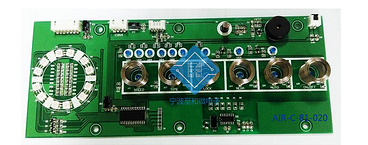PCB (PrintedCircuitBoard), the Chinese name is printed circuit board, printed circuit board for short, is one of the important parts of the electronics industry. Almost every kind of electronic equipment, from electronic watches, calculators, to computers, communication electronic equipment, military weapon systems, as long as there are electronic components such as integrated circuits, printed boards are used for the electrical interconnection between them. . In the research process of larger electronic products, the most basic success factors are the design, documentation and manufacturing of the product's printed board. The design and manufacturing quality of printed boards directly affects the quality and cost of the entire product, and even leads to the success or failure of commercial competition.
effect
After electronic equipment adopts printed boards, due to the consistency of similar printed boards, manual wiring errors can be avoided, and electronic components can be automatically inserted or mounted, automatic soldering, and automatic detection, ensuring the quality of electronic equipment, Improve labor productivity, reduce costs, and facilitate maintenance.

source
The creator of the printed circuit board is the Austrian Paul Eisler (Paul Eisler), in 1936, he first used the printed circuit board in the radio. In 1943, Americans mostly used this technology for military radios. In 1948, the United States officially approved this invention for commercial use. Since the mid-1950s, printed circuit boards have only begun to be widely used.
Before the advent of PCB, the interconnection between electronic components was done directly by wires. Nowadays, circuit boards exist only for experimental applications in laboratories; printed circuit boards have definitely occupied a position of absolute control in the electronics industry.
develop
Since the reform and opening up, due to preferential policies in terms of labor resources, market, investment, etc., China has attracted large-scale transfers of European and American manufacturing industries. A large number of electronic products and manufacturers have set up factories in China, which has led to The development of related industries within. According to Chinese CPCA statistics, in 2006, China's actual PCB output reached 130 million square meters, and the output value reached 12.1 billion US dollars, accounting for 24.90% of the global PCB output value, surpassing Japan to become the world's first. From 2000 to 2006, the average annual growth rate of China's PCB market reached 20%, far exceeding the global average. The global financial crisis in 2008 caused a huge impact on the PCB industry, but did not cause a catastrophic blow to China’s PCB industry. Under the stimulus of national economic policies, China’s PCB industry showed a full recovery in 2010. In 2010, China’s PCB output value reached US$19.971 billion. . Prismark predicts that China will maintain a compound annual growth rate of 8.10% from 2010 to 2015, which is higher than the global average growth rate of 5.40%.
printed boards have evolved from single-layer to double-sided, multi-layer and flexible, and still maintain their respective development trends. Due to the continuous development of high precision, high density and high reliability, continuous reduction in size, cost reduction, and performance improvement, the printed circuit board will still maintain a strong vitality in the future development of electronic equipment.
Summary of domestic and foreign discussions on the future development trends of printed board manufacturing technology are basically the same, that is, to high density, high precision, fine aperture, fine wire, fine pitch, high reliability, multilayer, high-speed transmission, light weight, The development of thin type, in the production, at the same time, to increase productivity, reduce costs, reduce pollution, and adapt to the development of multi-variety, small-batch production. The technical development level of the printed circuit is generally represented by the line width, aperture, and thickness/aperture ratio of the printed circuit board.